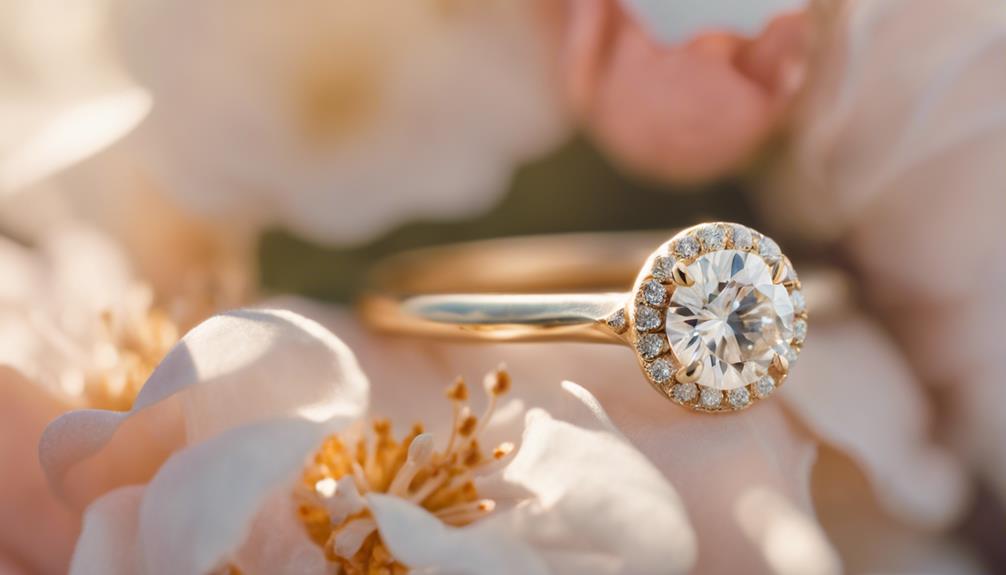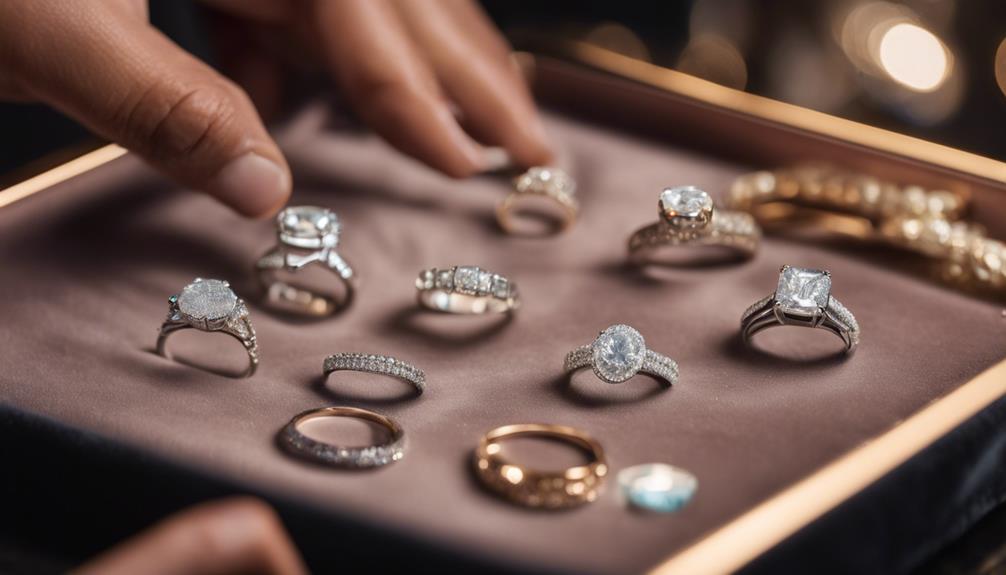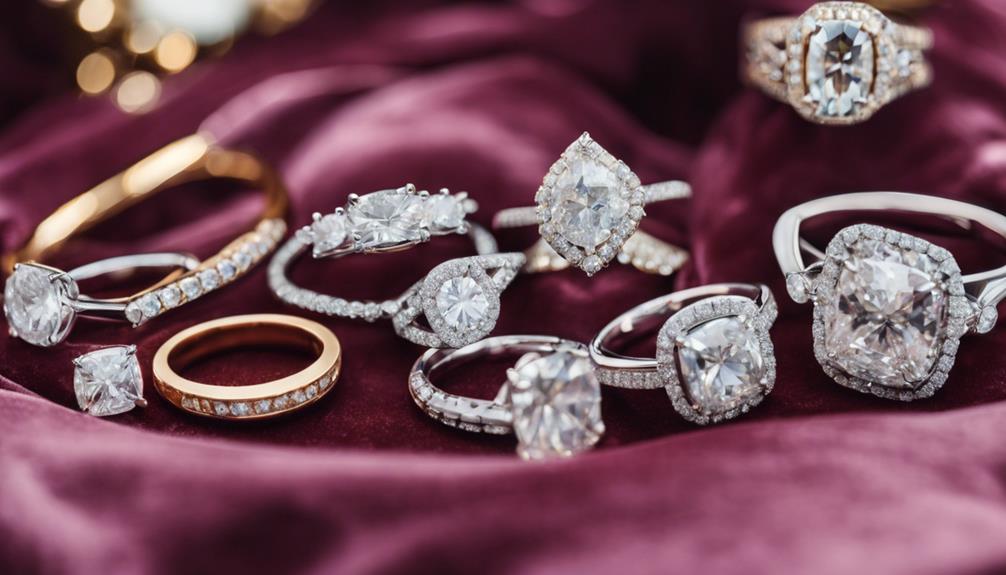You’re probably wondering what size engagement ring is most common. In the U.S., many couples choose rings with diamonds ranging from 1 to 2 carats. This range balances affordability with visible impact, making it a popular choice. The average isn’t static, though—urban areas tend to go bigger, around 2.5 carats, while smaller cities often prefer between 0.5 to 0.7 carats. Regional preferences and generational trends greatly influence these sizes. Understanding these nuances can guide you to the perfect ring choice. There’s a lot more to uncover about engagement ring size decisions and factors.
Average Engagement Ring Size

How big should an engagement ring be? When you’re considering the average engagement ring, the carat weight is a key factor. In the U.S., the current average engagement ring size is about 1.7 carats. However, there’s an expectation that this average diamond size might slightly decrease to around 1.5 carats in 2024.
Typically, you’ll find that about half of the rings sold fall between one to two carats. This range seems to hit the sweet spot for many, balancing between affordability and the desire for a noticeable stone.
Interestingly, preferences can vary considerably based on location. In larger cities like New York City and Los Angeles, the average diamond size tends to be around 2.5 carats, suggesting a preference for larger stones. Conversely, smaller cities often favor diamonds ranging from 0.5 to 0.7 carats.
The trend towards bigger diamonds is noticeable, with an 8% increase in average ring size from the previous year.
Globally, you might see a different picture. For instance, in Europe, the average diamond size is about 0.5 carats, with the UK slightly higher at 0.6 carats.
Ultimately, the choice of an engagement ring size reflects personal taste and budget.
Factors Influencing Ring Size
Choosing the right engagement ring size isn’t just about aesthetics; it’s influenced by a variety of factors that guarantee the ring fits perfectly and comfortably.
First, knowing the average ring size is vital. For women, it usually falls between 6 and 7, whereas men’s average ring size ranges from 10 to 11. But don’t rely on averages alone. Seasonal changes can affect finger size, so consider the time of year when purchasing. Warmer months might cause fingers to swell, while colder months could make them shrink.
To accurately determine your ring size, use methods like a ring sizer or measuring string, or consult with a jeweler for precision. Remember, resizing is always an option if the initial choice doesn’t quite fit. Professional resizing guarantees accuracy and keeps the ring settings intact.
Lifestyle plays a significant role in choosing the right ring size. If you’re active or frequently use your hands, opting for a slightly looser fit might be wise to guarantee comfort and prevent damage.
Balancing practicality with style is key. By considering these factors, you can select a ring size that complements both your lifestyle and personal preferences.
Regional Size Preferences

Across different regions, engagement ring size preferences vary considerably, influenced by cultural, economic, and lifestyle factors. In the U.S., the average diamond carat weight for an engagement ring is about 1 carat. However, cities like New York and Los Angeles see engagement ring sizes averaging closer to 2 carats. These regional differences highlight how financial stability and urban lifestyle choices impact what you might choose for your own engagement ring.
When considering where you live or plan to propose, it’s important to recognize these variances:
- Urban vs. Rural: Affluent cities often feature larger average diamond sizes, around 2.5 carats, compared to smaller towns with a range between 0.5 to 0.7 carats.
- Mid-Atlantic vs. Midwest: Couples in the Mid-Atlantic region typically spend more on engagement rings, reflecting not just financial stability but also differing regional preferences.
- U.S. vs. U.K./Europe: The average diamond carat weight in the U.K. is roughly 0.6 carats, and in Europe, it’s around 0.5 carats, contrasting with U.S. preferences for larger stones.
Understanding these distinctions can guide you in selecting a ring that not only aligns with your personal taste but also resonates with the regional norms of your community.
Trends Among Generations
Reflecting on shifting preferences, engagement ring trends among generations reveal notable differences in carat choices and spending habits.
Younger couples, often in their 20s to early 30s, typically opt for engagement rings with diamonds between 1 to 2 carats. This preference indicates a trend toward slightly smaller stones compared to older generations. The average carat size for engagement rings in the U.S. is currently around 1.7 carats, but a decrease to 1.5 carats is expected in 2024, highlighting changing preferences among younger buyers.
Millennials often spend less on engagement rings than older generations, resulting in a lower average carat size in their selections. This shift is partly due to financial considerations and a growing emphasis on practicality over tradition.
Additionally, the increasing popularity of lab-grown diamonds among younger couples plays a role in these trends. Lab-grown diamonds offer a budget-friendly and ethically conscious alternative, allowing couples to select a larger engagement ring size without compromising their values.
In contrast, older couples, with greater financial stability, tend to favor larger diamonds, reflecting their ability to invest more in their engagement rings.
These generational differences continue to shape the landscape of engagement ring preferences.
Tips for Choosing Your Size

When you’re selecting the perfect engagement ring, determining the right size is essential for both comfort and practicality.
Start by understanding that the average ring size for women falls between 6 to 7, and for men, it’s typically between 10 to 11. This can guide your initial decision.
To guarantee an accurate measurement, use a ring sizer or a piece of string to measure the finger. Remember, finger sizes can fluctuate with seasons, so it’s wise to take measurements at different times of the year.
Here are three tips to help you choose the right size for engagement rings:
- Measure Carefully: Use a ring sizer for an accurate measurement. Knowing your exact ring size minimizes the need for adjustments later.
- Consider Seasonal Changes: Finger size can change with temperature and humidity. Measure during different seasons for the most consistent fit.
- Seek Professional Help: If the ring doesn’t fit perfectly, professional resizing is an option. Experts can adjust the ring size without compromising its integrity.
Ultimately, lifestyle and daily wear should dictate your choice, emphasizing comfort and practicality for long-term satisfaction.
With these tips, you’ll find the perfect fit.
Conclusion
As you commence on the journey to find the perfect engagement ring, remember to balance personal taste with popular trends. While the average center stone in the U.S. ranges from 1.08 to 1.2 carats, your choice should reflect your unique love story. Consider regional preferences, generational trends, and, most importantly, what resonates with you and your partner. Embrace this special moment to select a ring that captures your style and fits harmoniously within your budget.



